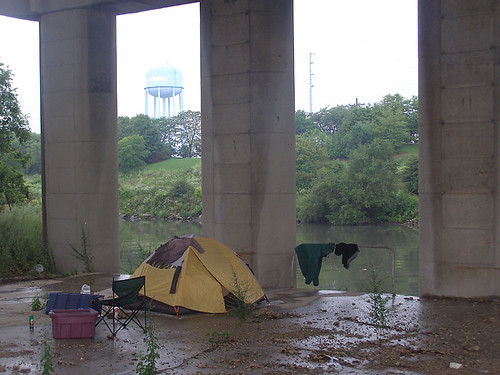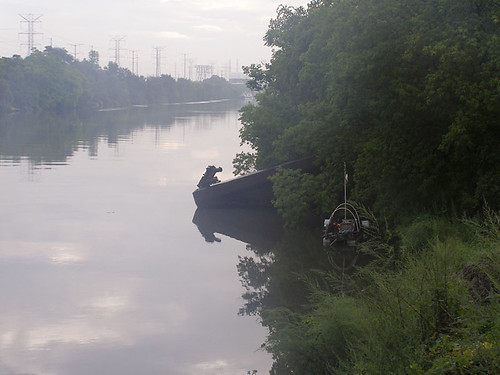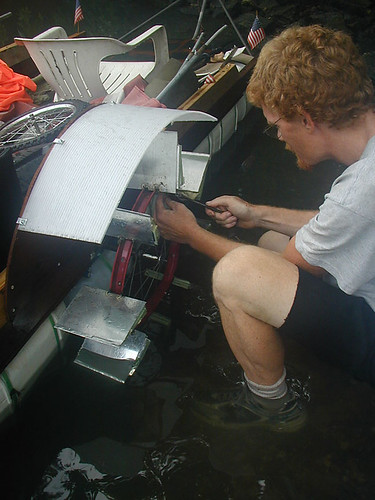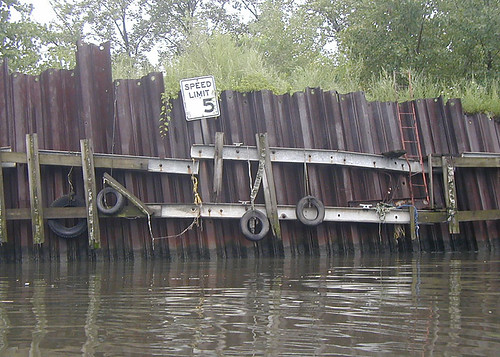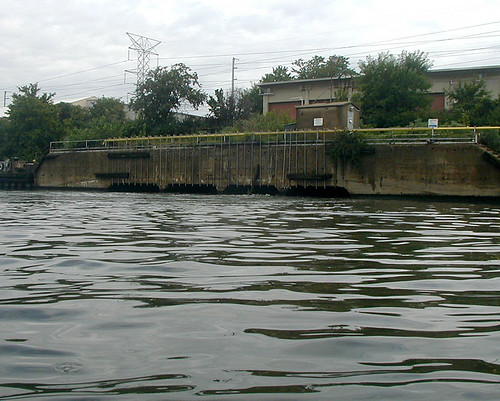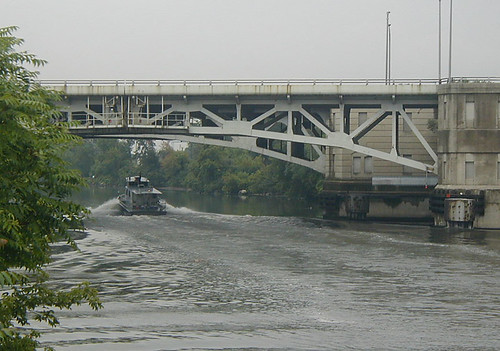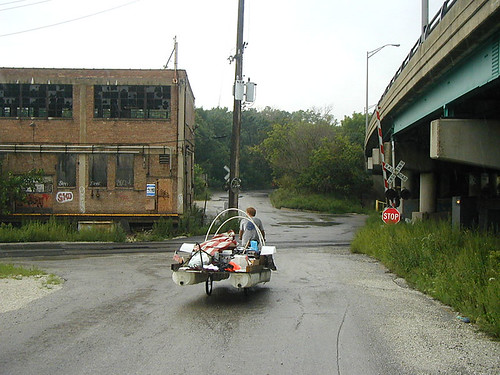All night long the rain fell by the cupful and bucketful, but we felt clever at finding this little hiding place under the bridge. The humidity was so high nothing really dried out, but at least it didn't get wetter. Periodically I was awoken by rumbling diesels of towboats on the water below us in the night, or freight trains on the tracks to the other side of our camp, or trucks on the bridge above and airplanes blasting off from Midway, but all in all it was a snug place to sleep in the rain.
In the gauzy morning we looked across the river at the lush lawns of the sewage treatment plant campus. But really our scrappy campsite was more comfortable than all that green grass. Looking down on the boat, tied to a tree nearby, we could see that the water had risen a foot or more overnight.
While making breakfast a boat came tearing down the canal. Bigger than the usual speedboat, it was a working yacht belonging to the Metropolitan Water Reclamation District, charging at full speed. We ran to the wall overlooking the river but there was nothing we could do. The enormous wake thrown behind the boat turned into 3-foot breakers as it crashed entirely over our little raft, smashing it against the rocks again and again mercilously.
Climbing down the rough bank, our trail from last night now under the rising water, we finally made it down to inspect the damage. The right paddle wheel had taken the brunt of the beating and was now bent and mangled. It took some twisting and spoke tensioning to get it back straight again and we were ready to set off.
So many things built along the river are now abandoned or simply battered into ruin. The river wrecks everything. The old boatyard where we'd camped looked as if it had been an elaborate undertaking in its day, with concrete foundations showing where there had been buildings, crane footings, stairs and levels. How many years ago was it still open? Maybe only ten? How quickly do these endeavors fall apart?
Other than that Reclamation District boat we saw no other traffic on the river. On the right (north) bank we knew that the world's largest sewage treatment plant was there, but there wasn't anything to see. Just trees along the bank. Kingfishers and green herons flew back and forth along the trees in pairs. Occasionally a fish jumped. It was a picturesque natural scene as we drifted by the many outflow tunnels of the sewage treatment plant.
Finally we crossed under the Harlem Avenue Bridge and headed to the bank to find a place to begin our portage. We knew that up ahead the shipping canal narrowed to half its width and would not be a pleasant place for little boats to play among the barges and powerboat wakes as we'd seen this morning. So we had planned to portage the boat on its little wheels over to the Des Plaines river, which runs parallel to the shipping channel nearly all the way to Joliet.
But these steep banks! Nowhere were there easy places to pull the boat out of the water. All along the river the sides were made of broken concrete and rebar twenty feet high, topped with a gravel road. We pulled our little bike off the back of the boat and used it to scout out the portage ahead. Mike found a way to the other river by following the road downstream, but it involved getting the boat around a gate and a railing. In the other direction, the road lead onto busy Harlem Avenue and eventually to a forest preserve. But first we had to pull the boat up the rocks and put its wheels on.
We unloaded all our gear and hauled it up the bank. How did we end up with so much useless junk? So many little things were thrown on the boat at the last minute, but with the constant rain we'd never really had the chance to sort them out. A last minute paper bag of odds-n-ends was quickly destroyed in the rain and boat wakes splashing over the deck. But now we had to pick up all those loose pieces and bring them up the rocks.
Finally we were ready for the boat itself, when suddenly that dreaded Reclamation District yacht appeared again, tearing back up the canal. I jumped off onto the rocks, but fortunately this time the yacht slowed for us, lessening the wake, and we received no more damage as they kicked up their engines again and sped away.
So we took the front of the boat and pulled it forward up onto the rocks. This was simple enough when the stern was still on the water, but as the boat came up out of the water it grew increasingly heavy. With one of us lifting the side, and another pulling from the front we inched up the jumbled concrete incline, scraping and cursing. Sometimes it would even slide backwards, and we used up all our strength to get it back up a few inches, until it seemed we were stuck. It was just too heavy for only two people to lift up this rugged bank.
Just then a car stopped on the road above. I thought it was just a curious passerby, but it turned out to be a Water Reclamation District cop, who mentioned that we were trespassing on District property, but seemed intrigued by what we were doing. Why were we hauling all this junk up the bank? We explained that we were trying to portage to the Des Plaines to get out of the Sanitary Canal. A good idea, he agreed, and offered to help us. So with the cop pulling on the front rope, and Mike and I hefting the axles on the sides, we scraped and dragged the boat all the way up to the grass beside the road on top. What an ordeal! And what a blessing that a stranger showed up at just the right time to help out!
Thoroughly exhausted, we had some lunch and made a run to get water at a nearby gas station and decide what to do. Eventually we got the trailer wheels back on the boat (for some reason more difficult than it had been in the garage), nearly lost one of the wheels as it fell back bounding down the rocks and bounced to a stop just beside the water. Hitched the trailer back to the bike and loaded up all the gear, and we were ready to go.
We decided that the Harlem Avenue route would be better, despite the busy road, so with one of us riding the bike, and another running behind giving a little extra push we rolled on down the road across some train tracks, down over a little bridge over the scummy remnants at the edge of old Mud Lake and out onto Harlem Avenue right by the monument to the Chicago Portage used by Joliet and Marquette and a hundred other voyageurs to cross the continental divide between the Great Lakes and the great rivers leading to the Mississippi.
But that was long ago. Over the last hundred years, the Chicago Portage has been obliterated by the filling of Mud Lake, the construction of the Sanitary Canal, reversal of the Chicago River, the rerouting of the Des Plaines and building levee systems to keep it all in place in high or low water. Right now we were riding backwards along the left hand side of Harlem Avenue, a little bike pulling a wide trailer against oncoming traffic. We had found a break in traffic, expecting the stoplight ahead to change and hold up the speeding cars, but it never did. Right now there was a huge panel truck coming right at us, without changing lanes. I was readying a dive for the shoulder in this game of chicken. I don't know what Mike was planning to do.
Suddenly one of the oncoming cars flashed its lights and an undercover cop rolled down his window. "Boys, I suggest you get off the road!!" he barked at us. But even he succumbed to the panic of onrushing traffic and raced off with the rest of them. Finally the cars cleared for a moment and we made a break for the little gravel road leading up to the train tracks that was our goal.
From there we hurried up the two-track road, hoping the cop hadn't seen us, a ramp up the embankment to run alongside the railroad track and on down to a low bridge over the Des Plaines. Hooray! We made it!
Day 3 Down in the Flood
